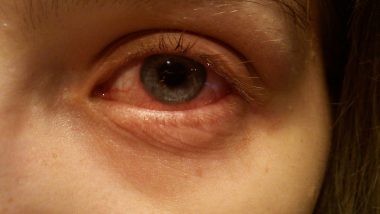When the translucent membrane that lines the eyelid and eyeball, the conjunctiva, develops an inflammation called Conjunctivitis Eye Infection. Small blood vessels in the conjunctiva become more apparent when they are inflamed and swollen, which causes the white to turn reddish or pink colour. Viral infections are the most frequent cause of pink eye. Additionally, bacterial infections, allergic reactions, and — in infants — partially opening tear ducts can also be responsible for it. Cases of Conjunctivitis, Other Eye Infection on Rise in Delhi: Doctors.
Pink eye might be a pain, but it rarely impairs your eyesight. Pink eye irritation can be reduced with the use of treatments. Receiving an early diagnosis and implementing specific precautions can help minimise the spread of pink eye because it can be contagious.
Pink Eye (Conjunctivitis): What is it?
Inflammation (redness) of the conjunctiva, the transparent tissue that lines the inner surface of your eyelid and the outer layer of your eye, results in pink eye. Your eyelid and eyeball are kept moist with the aid of this tissue. Viruses, bacteria, allergies, and other factors can all cause pink eye. Pink eye is the common name of this condition which in medicine is conjunctivitis. Pink eyes can affect one or both eyes.
Conjunctivitis Symptoms
The most typical signs of pink eye include:
- Either one or both eyes are red.
- Either one or both eyes are itchy.
- An unpleasant sensation in one or both eyes.
- A discharge in one or both eyes develops a crust during the course of the night and may make it difficult for your eye(s) to open in the morning.
- Tearing.
- Light sensitivity, also known as photophobia.
Pink Eye Causes
The conjunctiva, the membrane that covers your eye, becomes irritated, which makes the blood vessels in it more visible, giving pink eye its pink or reddish hue. An inflammation's causes include:
- Viruses: The most frequent cause of pink eye is viruses. One group of viruses that can cause pink eye is the coronavirus, which includes the common cold and COVID-19.
- Bacteria: Bacteria like Staphylococcus aureus, Haemophilus influenzae, Streptococcus pneumonia, and Pseudomonas aeruginosa are frequently responsible for bacterial conjunctivitis.
- Allergens: Moulds, pollen, and other allergens fall within this category.
- Irritant: This includes dirt, smoking, contact lenses, cosmetics, shampoos, and pool chlorine.
- STIs, or Sexually Transmitted Infections: STIs can be brought on by bacteria (gonorrhoea or chlamydia) or viruses (herpes simplex). STIs can bring on pink eye in both adults and babies.
- Autoimmune Diseases: Pink eye is a rare complication of illnesses that cause the body's immune system to overreact.
Conjunctivitis Eye Infection Precaution
Pink eye can be stopped in its tracks by practising good general hygiene and ocular cleanliness like these:
- Avoid rubbing or touching the affected eye(s).
- Wash your hands with soap and water frequently.
- Use new cotton balls per day to wipe away any discharge from your eyes.
- After discarding the cotton ball, wash your hands in warm soapy water.
- After using eye drops or ointment on your own or another person's eyes, wash your hands.
- Never exchange personal goods like towels, cups, makeup, or contact lenses.
A number of dangerous eye disorders can bring on eye redness. Eye pain, the sensation that something is stuck in your eye, impaired vision, and light sensitivity may be brought on by these disorders. Seek urgent care if you develop these symptoms.
Contact lens wearers must cease wearing their lenses as soon as pink eye symptoms appear. Make an appointment with your eye doctor to ensure you don't have a more serious eye infection related to contact lens use if your symptoms don't start to improve within 12 to 24 hours.
(The above story first appeared on LatestLY on Aug 03, 2023 01:44 PM IST. For more news and updates on politics, world, sports, entertainment and lifestyle, log on to our website latestly.com).













 Quickly
Quickly





















